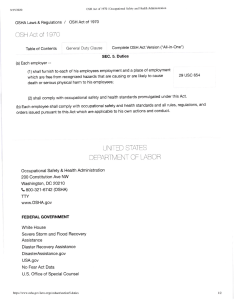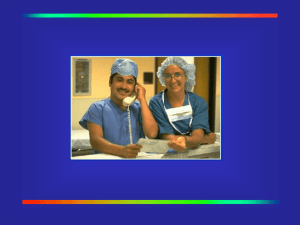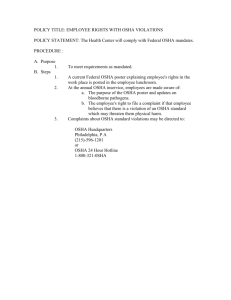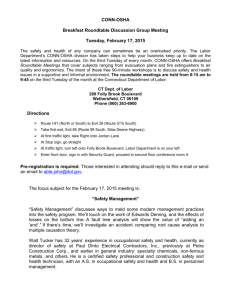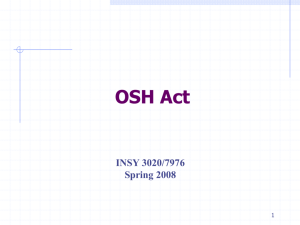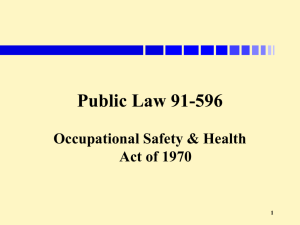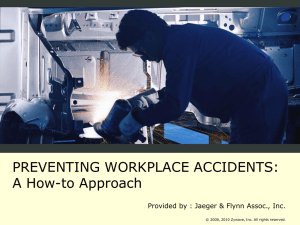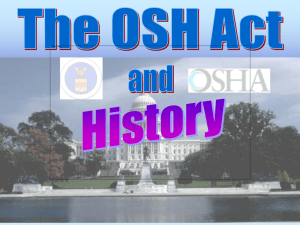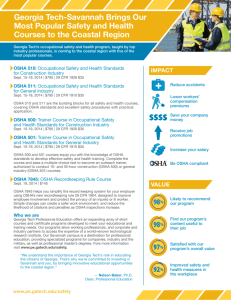Document
advertisement
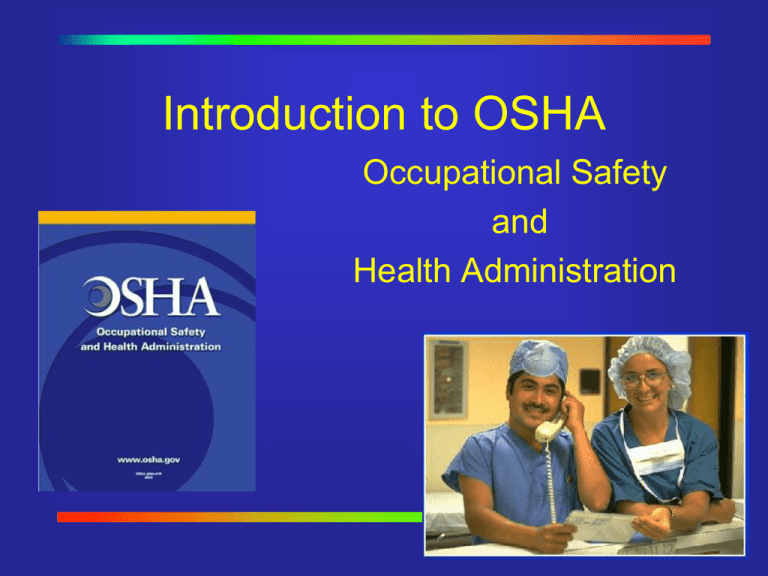
Introduction to OSHA Occupational Safety and Health Administration What’s wrong in this hallway? Injuries and Deaths • >6, 000 workers die each year • 5.7 mil (out of 105 mil) workers are injured on the job each year (1999) – strains and sprains are very common • 1.7 mil workers are disabled each year (1999) Permanent or temporary Accident Triangle Deaths (6,000) (Approximate Numbers) Lost workdays (3,000,000) 1000 x Recordables (6,000,000) 500 x ?x ?x ?x First aid Not reported Near misses Note: Based on Bureau of Labor and Statistics Workplace Injuries •All industry-6.3 per 100 workers •Health services-7.7 per 100 workers •Hospitals-8.4 per 100 workers •Nursing and Personal Care workers 13.8 per 100 workers Note: Based on Bureau of Labor and Statistics Purpose of OSHA & MIOSHA PROVIDE A SAFE WORKPLACE •www.osha.gov OSH ACT 1970 • Created these divisions to oversee safety: • OSHA (enforces compliance via inspections) Occupational Safety and Health Administration • NIOSH (conducts research for safety products) National Institute for Occupational Safety and Health • OSHRC (appeals & citation management) The Occupational Safety and Health Review Commission General Duty Clause 5(a) OSH act 1970 •5(a) Employer Responsibility “(1) furnish employees employment which is free from recognized hazards likely to cause death or serious physical harm to employees” General Duty Clause 5(b) •5(b) Employee Responsibility“(b) Employee shall comply with OSHA standards and all rules and regulations which are applicable to his own actions and conduct.” Michigan Act 154 •R408.1011 Section 11: An employer shall:...Furnish a place of employment which is free from recognized hazards that are... likely to cause…death or serious harm... Michigan Act 154 •408.1012 Section 12 An employee shall: Comply with (safety) rules and standards... INSPECTONS (without advanced notice) •Imminent danger •Catastrophes and fatal accidents •Employee complaints •Programmed high hazard inspections (i.e. hospitals) •Follow-up Imminent Danger •IDLH (“A REASONABLE PERSON”) IMMEDIATLY DANGEROUS TO LIFE & HEALTH (i.e. exposed electrical wire) •Need correction ASAP Catastrophes and Fatal Accidents •Must Report in 8 Hours 3 EMPLOYEES HOSPITALIZED FROM SAME ACCIDENT or 1 FATALITY Code of Federal Regulations (CFR) •Each day regulations are passed by Congress, they are published in Federal Register •Each rule is placed in 1 of 50 Titles • •Title 29 is LABOR Code of Federal Regulations (CFR) •29 CFR - rules for “Department of Labor” •Title 29 CFR 1910 - rules for Labor in General Industry •Healthcare is "General Industry“ •Healthcare must follow all federal & state rules & standards OSHA 200/300 Log •Helps identify: Types of accidents Departments that are having accidents Employees that are having accidents •By knowing this information, accidents can be reduced in numbers OSHA 200 Log Legal form to record injuries & illnesses (& medical tx for work-related injury) Must be posted in your work area for the month of February Must be kept up-to-date Common Hospital Violations •1. No annual BBP training for employees •2. Employees not wearing PPE •3. Failure to act appropriately for postexposure •4. Failure to consider safer medical devices •5. Recapping needles •6. Employer not offering Hep B Vaccine State Plans • The OSH Act of 1970 allowed states “to assume responsibility for…OSHA standards…” • The stipulation was they must “… be at least as effective...” as federal government’s standards. •26 states have state plans. MIOSHA Michigan Occupational Safety and Health Act Act 154 of 1974 “state plan state” “state program” Whistleblower Protection •Section 11( c ) of the OSH Act of 1970 •“Workers have the right to complain to OSHA and seek an OSHA inspection...” (without discrimination) What should you do? •1. If you see a hazard in the work area? •2. If you spill something? •3. After you finish working with a sharp object?
